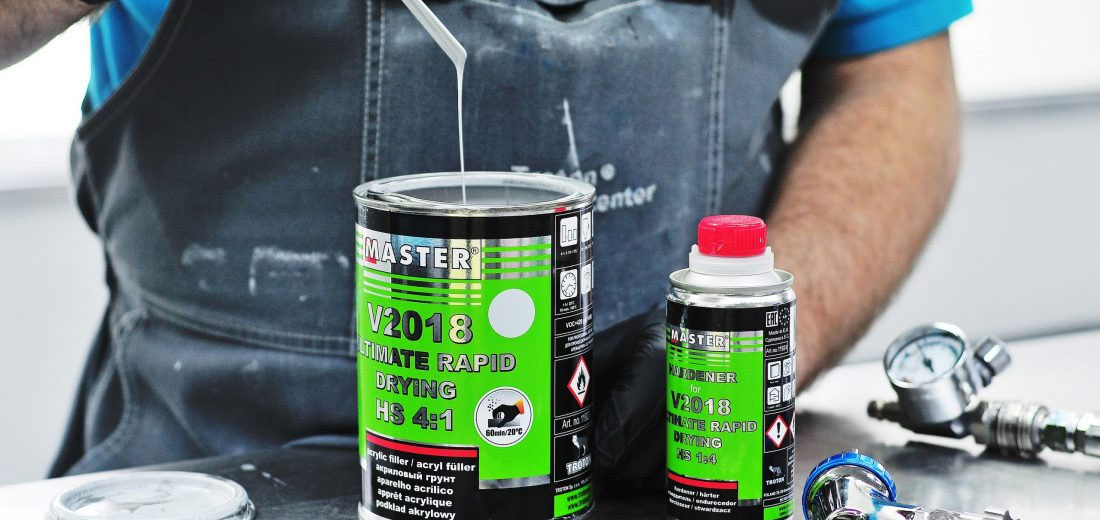Filling primers – how to use them correctly?

Primers are used during varnish coating repair. Their role is to create an isolation layer between substrate and putty and between putty and clearcoat. They offer an adequate adhesion to clearcoat and level off little dimples in coating, which needs to be repaired.
Before primer application, the surface needs to be properly prepared. It has to be sanded, degreased and rust needs to be removed as well. Thanks to all these aforementioned steps, the metal substrate will be isolated from putty layers, which will be applied in later stages. It is important to remember that putties have hygroscopic properties. If we apply it directly on metal panel, we will not be able to stop the corrosion but it also might be sped up. When applying putty on primer with anticorrosion, adhesion and isolation properties, we will fill the dents to create surface in a right form. When we finish applying putty and preparing the substrate, we can start to remove the rest of dust and degrease. We come up with the surface ready to be taped and painted with primer. Every next layer needs to be applied wider than the previous one. It will make that up to the edge of the repaired part the primer will be shaded.
Let’s talk about other conditions that need to be met when applying a varnished layer. It is important that the substrate is protected against corrosion. All dimples need to be filled in such a way to show the original shape. Such an effect can be achieved by using putties and filling primers. The whole needs to be covered with a layer of colour and alternatively with an additional clear coat. The layer’s thickness, applied in such a way, is 120-180 µm. Sometimes it might be more, if these are parts which require putty application. The thickness of the factory-made coating is much smaller and is around 100-140 µm. Aforementioned thickness of the lacquered coatings will sufficiently protect bodywork against corrosion and we will be able to guarantee the durability of the repair.
Epoxy primer is known as the best repair technology. It is applied directly on the substrate after it is sanded and cleaned off. It is important to remember that putty reinforced with carbon and glass fiber has a weak adhesion. However, other varieties of putties do not have such a problem with adhesion, so can be used with success. If we want to seal up the basis’ perforation by using putty reinforced with carbon or glass fiber, the first thing we need to do is to get rid of perforation. Next step is to apply e.g. a reactive primer on a repair part, then we use acrylic filler. When using a reactive primer (polyvinyl wash primer) with the basis, putty cannot be applied. Our choice of fillers is then limited to acrylic primers. A smaller protection will be achieved by using 1K products. They consist of aggressive thinners which can react with the prior coating damaging it. In some cases, filling polyurethane primers on water based systems can be used. However, before we use them, the basis needs to meet certain conditions. It has to be well insulated and filled.
Fillers with anticorrosion properties are widely used not only in the refinish industry. They are used when fences are lacquered or for equipment in the garden and body shop protection. Where a possibility of exploitation in hard conditions might occur, additional protection is used in order to minimize negative environmental impact. Special anticorrosion products are widely used in such industries as: aviation, shipbuilding or agricultural machinery. The same in the automotive industry, they are used in many steps of production. This is why, we can be sure currently produced cars are properly protected. Actually, in the past additional anticorrosion protection such as paints and minium primers were used. They did not give any esthetic and colour qualities, not mentioning a proper smoothness. Current technologies ensure that products available have much better quality and give better results and safety. It is extremely important when repairing cars following accidents, as we want to ensure the quality and durability of the repair process will not be much different from factory-made ones. Primers are crucial here. If we use well matched products according to their characteristics, we will end up with a result which will satisfy both a car refinisher and a client.